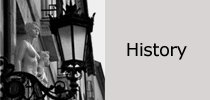
|

|

|

|

|

|

|

|

|
Legends of Salamanca
- The cave of Salamanca
- The façade of the University
- House of the dead
- Tentenecio Street
- The Mariquelo
The cave of Salamanca
La Cueva de Salamanca es un enclave legendario de la ciudad de Salamanca donde, según la tradición popular, impartía clase el Diablo. Dicha cueva se corresponde con lo que fue la cripta de la ahora inexistente iglesia de San Cebrián.
The cave of Salamanca is a legendary enclave of the city of Salamanca where, according to the popular tradition, the Devil gave classes. This cave corresponds to what became the crypt of the non-existent church of San Cebrian. The popular tradition, forgetful of Hercules, soon assigned the teaching labor to Asmodeo or another demon, who, for seven years, in the shadow of the night, he gave classes of divination and other dark arts to seven students. Once the course was finished, they had a draw amd whoever lost would be at the hands of the devil forever. According to the legend, the Marquis of Villena was one of the most gifted students of the Devil who managed to escape alive, but without his shadow which he lost forever to the devil.
A variant of the tales is that Pierre de Axular was the one that stayed behind.
As well as the Devil, it’s said that Clemente Potosí was also a speaker.

The façade of the University
The frog, which appears on a skull and decorates the façade of the original building of the University, constitutes to one of the principal touristic attractions of the city and also has its own history. According to the legend, if a student doesn’t see it, he’ll fail in his studies.
It’s origin, the reality, is probably symbolised by lust (since this is not really a frog, but a toad, symbol of the female sex) which leads to the death (the skull on which it is sat) and was a souvenir to the students who had to centralise their efforts on studying and not devoting themselves to other things.

House of the dead
"The house of the dead" is called this because of the skulls which cover its façade. During the time when the building was renovated, the skulls rounded and converted into balls, which made it gloomy. The people invented a famous tale, which has stayed with it for years and years. According to the legend, the name comes from the fact that a dead woman was discovered in the house but no one could explained how it happened.
The malediction fell on the house and according to the tale, everyone who goes in the house will certainly die. This place stayed empty for a long time and people who pass the house lower their voices mysteriously. Now, the faces have been re-sculpted into skulls (but smaller than the originals).

Tentenecio Street
A popular legend tells that Tentenecio Street has its name from San Juan de Sahagún who, once, walked in this street and approached a big bull which had escaped from the market and was running crazily. Sahagún shouted "Try, fool!" and the bull, stopped amazingly. The name of the street comes from this tale.
Another street which makes us remember the Saint is Pozo Amarillo Street, where a child fell into a pit and was fortunately saved, because the level of the water was very high. Today, San Juan de Sahagún is still the patron of the city.

The Mariquelo
The Mariquelo is a mythical character of Salamanca who, each year, on the eve of the Festivity of the Saints, rises at the belfry of the New cathedral to honor the fact that the earthquake of Lisbon in 1755 strongly affected the structure of this building. Since his death, a family member has always celebrated the tradition until 1976, when this custom died.
In 1985, Ángel Rufino de Haro restarted the tradition and every year, wearing the Salmantinian costume, goes to the highest point of the tower of the cathedral to sing and play an instrument with a drum and a bagpipe.















 info@ciudaddesalamanca.es
info@ciudaddesalamanca.es